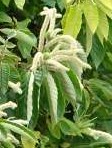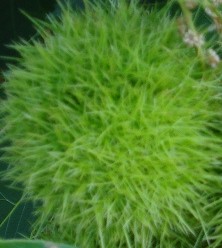 Native to Eastern US, the American chestnut is almost extinct in the wild because of the chestnut blight that was introduced on Japanese nursery stock in the late 1800s. Most of the trees found now are root or stump sprouts that grow for a few years before succumbing to the blight. At present there is no cure but scientists are working to breed resistant forms. Before 1900 the American chestnut was an important deciduous tree in Eastern hardwood forests and was valued for its nuts, lumber, and beauty. The trees are wide-spreading, graceful, and have arching branches and a smooth, round crown. They have grayish brown, lightly ridged bark and abundant light-green drooping leaves five to eleven inches long with sharply toothed margins. In June, the fragrant white male flowers are produced in erect catkins four to eight inches long while the similar female flowers are in smaller catkins. The fruit is a prickly brown bur, 2 to 2.5 inches across, that usually contains two shiny brown edible nuts. Trees produce fruit on new growth and need a winter chill to set good fruit. Suckering can be excessive.
Native to Eastern US, the American chestnut is almost extinct in the wild because of the chestnut blight that was introduced on Japanese nursery stock in the late 1800s. Most of the trees found now are root or stump sprouts that grow for a few years before succumbing to the blight. At present there is no cure but scientists are working to breed resistant forms. Before 1900 the American chestnut was an important deciduous tree in Eastern hardwood forests and was valued for its nuts, lumber, and beauty. The trees are wide-spreading, graceful, and have arching branches and a smooth, round crown. They have grayish brown, lightly ridged bark and abundant light-green drooping leaves five to eleven inches long with sharply toothed margins. In June, the fragrant white male flowers are produced in erect catkins four to eight inches long while the similar female flowers are in smaller catkins. The fruit is a prickly brown bur, 2 to 2.5 inches across, that usually contains two shiny brown edible nuts. Trees produce fruit on new growth and need a winter chill to set good fruit. Suckering can be excessive.
 Type: Deciduous tree
Type: Deciduous tree
Outstanding Feature: Shade, form
Form: Wide spreading, round crown
Growth Rate: Moderate to rapid
Bloom: Fragrant white male flowers produced in erect catkins four to eight inches long and similar female flowers in smaller catkins in June
Size: 50-100’ W x 70-110’ W
Light: Full sun
Soil: Average, moderately moist, well-drained; tolerates less
Hardiness: Zones 5-9
Care: Prune to develop good lateral branches for fruit production in winter or early spring before growth starts.
Pests and Diseases: Chestnut blight, weevil,
Propagation: Seed, division of suckers